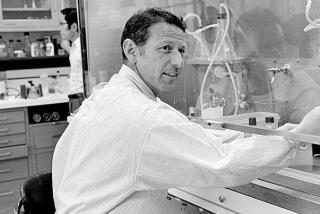Dr. Marshall R. Urist; Surgeon Pioneered Rebuilding of Bones
- Share via
Dr. Marshall R. Urist, UCLA orthopedic surgeon who made landmark breakthroughs in promoting the rapid healing of broken bones and rebuilding of lost bone tissue, has died. He was 86.
Urist, who taught at UCLA for half a century and headed three national orthopedic organizations, died Sunday in Los Angeles of cardiovascular disease.
“Marshall Urist was a medical giant,” said Dr. Gerald S. Levey, dean of the UCLA School of Medicine and provost of medical sciences. “He devoted his life to orthopedics, and many of the advances in that field came as a result of his clinical and research work. We have lost a great physician and scientist.”
Urist was probably best known for his discovery in 1965 of bone morphogenetic protein, or BMP, a genetically produced substance that helps bone to regenerate by inducing certain types of connective tissues and other unspecialized cells to become bone cells.
In more than 20 years of experimentation, Urist proved that BMP could be used to build living bone tissue around surgical pins and screws used to repair broken hips, shoulders and other bones.
“The availability of the protein [BMP],” Urist told The Times in 1987 as his “bone glue” was undergoing testing by the Food and Drug Administration, “will make it possible to repair large bone defects caused by old infection, injuries, removal of tumors and congenital deformities in children and adults.”
A prolific contributor to medical journals, Urist wrote of his early work on BMP in a 1965 Science magazine article that helped spark widespread research into bone autoinduction, or regrowth. The article was selected in 1997 as a Landmark Contribution to Science by the National Institute of Health Research.
But that breakthrough was merely the most significant in a long string of innovations by Urist to improve orthopedic care. Fifty years ago, he was experimenting with animal bones--primarily those from bulls--to repair fractures.
In 1962, he successfully used bull bones to repair the broken hips of more than 50 elderly Los Angeles people, assuring The Times: “Their hips are now as strong as oak, even stronger than natural hips.”
At the time, Urist predicted animal bones would replace use of metal pins to repair human bone fractures. But at the same time, he stepped up his own research to find BMP, the “glue” that would help build natural human bone around more refined metal pins.
As an expert in animal as well as human bones, in the 1960s Urist was also a research associate in vertebrate paleontology at the Los Angeles County Museum of Natural History.
Urist, a phenomenon from the time he entered the medical profession, served with the U.S. Army Medical Corps in Europe during World War II. He earned the Sir Henry Wellcome Award for his original research on military surgery, especially his work on open hip fractures and other injuries during wartime.
At war’s end, then only 31, Urist became regional consultant in orthopedic surgery at Supreme Headquarters Allied Expeditionary Forces and chief of orthopedics at the 97th General Hospital in Frankfurt, Germany. Later he worked at the Pentagon and, with Mather Cleveland, co-wrote the historic book “Orthopedic Surgery in World War II in the European Theater of Operations.”
Urist taught physiology and research at the University of Chicago before joining the UCLA School of Medicine faculty in 1954.
Born in Chicago and brought up on a small farm near Glen, Mich., he earned a bachelor’s degree in chemistry from the University of Michigan, a master’s degree from the University of Chicago and his medical degree from Johns Hopkins University.
During his long career, Urist served as president of the Assn. of Bone and Joint Surgeons, the Society of International Research in Orthopedic Surgery and Traumatology and of the Hip Society.
Among his books were the 1968 “Fundamentals of Physiology of Bone” and the 1980 “Fundamental and Clinical Bone Physiology.” He wrote more than 400 scientific articles and for many years edited the journal Clinical Orthopedics and Related Research.
As a hobby, Urist grew avocados near Fallbrook in San Diego County.
He is survived by his wife of 59 years, Alice; their three children, Dr. Marshall Jr., John, and Nancy Miller, and eight grandchildren.




